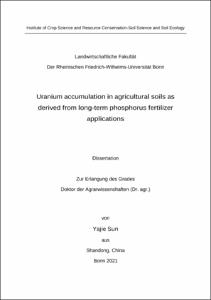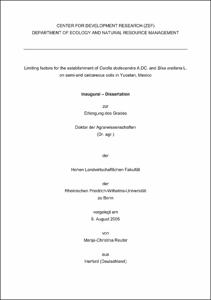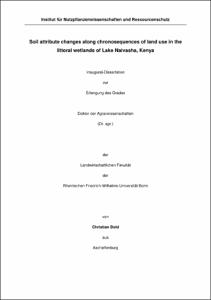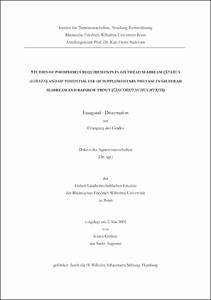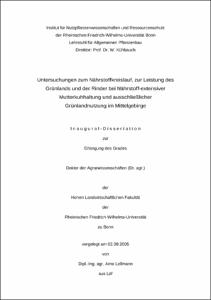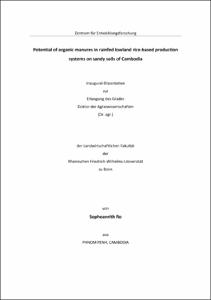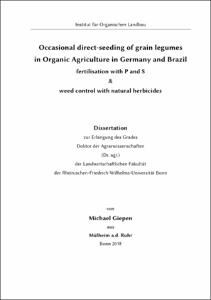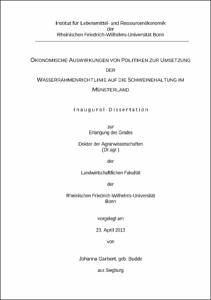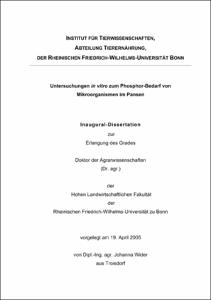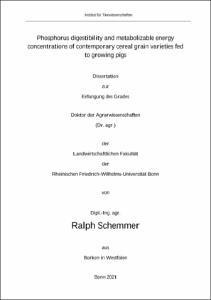E-Dissertationen: Search
Now showing items 1-10 of 11
Uranium accumulation in agricultural soils as derived from long-term phosphorus fertilizer applications
(2021-03-04)
It is well known that uranium (U) in mineral phosphorus (P) fertilizers may accumulate in agricultural soils; yet, this U accumulation occurs at different rates, likely depending on the type of fertilizer used. To substantiate ...
Limiting factors for the establishment of Cordia dodecandra A.DC. and Bixa orellana L. on semi-arid calcareous soils in Yucatan, Mexico
(2006)
In Northern Yucatan, huge areas of abandoned sisal plantations, now assigned to the communities, require agroforestry management strategies that take into account the high spatial variability of soil, the lack of surface ...
Soil attribute changes along chronosequences of land use in the littoral wetlands of Lake Naivasha, Kenya
(2014-11-14)
Lake Naivasha is a freshwater lake in the East African Rift Valley, which was affected by a continuously declining water level between 1980 and 2011. The newly exposed littoral area has been gradually put under agricultural ...
Studies of phosphorus requirements in gilthead seabream (Sparus aurata) and of potential use of supplementary phytase in gilthead seabream and rainbow trout (Oncorhynchus mykiss)
(2005)
The aim of this study was to test plant feedstuffs as an alternative to fishmeal in diets for rainbow trout and gilthead seabream, focussed on the reduction of phosphorus excretion and the potential use of microbial phytase. ...
Untersuchungen zum Nährstoffkreislauf, zur Leistung des Grünlands und der Rinder bei Nährstoff-extensiver Mutterkuhhaltung und ausschließlicher Grünlandnutzung im Mittelgebirge
(2005)
Seit Einführung der Milchquotenregelung im Jahre 1984 ist die Anzahl der Mutterkühe deutlich angestiegen. Mutterkuhhaltung gilt allgemein als ökologisch vorteilhafte Form der Rinderhaltung. Zum Nährstoffkreislauf und zu ...
Potential of organic manures in rainfed lowland rice-based production systems on sandy soils of Cambodia
(2016-04-25)
Rainfed lowland rice is the dominant food crop in the low-input agricultural systems of Cambodia. The main production area is characterized by sandy soils with low contents in nitrogen, phosphorus and organic matter, as ......
Potenzial organischer Dünger in Reisanbausystemen auf sandigen Böden im Tiefland von Kambodscha
Regengespeister Nass-Reis ist das vorherrschende angebaute Nahrungsmittel in extensiven Agrarsystemen ......
Potenzial organischer Dünger in Reisanbausystemen auf sandigen Böden im Tiefland von Kambodscha
Regengespeister Nass-Reis ist das vorherrschende angebaute Nahrungsmittel in extensiven Agrarsystemen ......
Occasional direct-seeding of grain legumes in Organic Agriculture in Germany and Brazil: fertilisation with P and S & weed control with natural herbicides
(2018-02-13)
The aim of this work was to test strategies, which improve nutrient supply and weed control in occasional direct-seeded (DS) grain legumes in Organic Agriculture. The effect of intra-row fertilisation of rock phosphate ......
Ökonomische Auswirkungen von Politiken zur Umsetzung der Wasserrahmenrichtlinie auf die Schweinehaltung im Münsterland
(2013-10-31)
Die Landwirtschaft ist über die Ausbringung von Dünger Hauptverursacher diffuser Nährstoffeinträge in deutsche Gewässer. Sie ist somit mitverantwortlich dafür, dass das erklärte Ziel eines „guten ökologischen Zustands“ ...
Untersuchungen in vitro zum Phosphor-Bedarf von Mikroorganismen im Pansen
(2005)
Es wurden drei Versuche durchgeführt mit dem Ziel der Ableitung des P-Bedarfs von Pansenmikroorganismen.
In einem ersten Versuch wurden Bakterien aus flüssigem (LAB) und strukturiertem (SAB) Panseninhalt von Schafen ...
In einem ersten Versuch wurden Bakterien aus flüssigem (LAB) und strukturiertem (SAB) Panseninhalt von Schafen ...
Phosphorus digestibility and metabolizable energy concentrations of contemporary cereal grain varieties fed to growing pigs
(2021-02-01)
Cereal grains are a major feedstuff in pig nutrition across the world. Due to their high starch content and their high inclusion rates, they supply the majority of energy in diets for pigs. At the same time they also provide ...


